SEA CUCUMBER: FOOD AND MEDICINE
The pacific sea cucumber (Stichopus species and other members of the family Holothurioidea) has been revered by Chinese cooks since ancient times. In particular, sea cucumber meals have been offered on special occasions, especially New Year celebrations. An ancient Confucian recipe, translated roughly as "The Eight Immortals Crossing the Sea" and made with sea cucumber, shark's fin, and 5 kinds of fish and shellfish, is one of the classic banquet dishes. The sea cucumber is valued-along with several other delicacies, such as shark's fin, ginseng, cordyceps, and tremella-as a disease preventive and longevity tonic. It was listed as a medicinal agent in the Bencao Congxin (New Compilation of Materia Medica) by Wu Yiluo in 1757. The popular Chinese name for sea cucumber is haishen, which means, roughly, ginseng of the sea. It is often known in medical literature as fangcishen (fang = four-sided, ci = thorny; referring to the spiky protrusions that emanate from four sides) or, in abbreviated form, fangshen.
The Asian demand for sea cucumber has been so high that these have been collected from the U.S. and other countries (e.g., Australia, Philipines) to get an adequate supply. The Atlantic sea cucumber,Cucumaria frondosa, has been collected primarily for food, but has recently been researched as a source of medicinal components, thanks to the efforts of Coastside Bio Resources in Maine, headed by Peter Collin.
PREPARATION AND USE OF SEA CUCUMBER
To prepare the sea cucumber after it is collected, the internal organs are removed, and dirt and sand are washed out of the cavity. It is then boiled in salty water and dried in the air to preserve it. When readied for use in making food, the hard, dried sea cucumber is softened. The process is quite lengthy, which is why this food tends to appear at special dinners and banquets more so than in day-to-day cuisine. To soften the dried sea cucumbers, the instructions are: place the sea cucumbers in a pot and add cold water to cover; soak for at least 12 hours; then cook over low heat for 1 to 2 hours; add more water, as necessary, to make sure that the water always covers the cucumbers; remove from heat and let cool to room temperature, then drain.
According to analysis by principles of traditional Chinese medicine, the sea cucumber nourishes the blood and vital essence (jing), tonifies kidney qi (treats disorders of the kidney system, including reproductive organs), and moistens dryness (especially of the intestines). It has a salty quality and warming nature. Common medicinal uses of sea cucumber in China include treating: weakness, impotence, debility of the aged, constipation due to intestinal dryness, and frequent urination. The sea cucumber properties may be compared with certain other common Chinese tonics that are used in food therapy, such as cordyceps (dongchong xiacao; which tonifies yang and is less moistening) and tremella (yiner; which nourishes yin and is moistening, but is less effective as a blood tonic). For yin and blood deficiency, especially manifesting as intestinal dryness, sea cucumber is combined with tremella to make a soup. For impotence, frequent urination, and other signs of kidney deficiency, sea cucumber is cooked with mutton. For nourishing essence and blood in persons who suffer from emaciation, it is combined in soup with pork.
From the nutritional viewpoint, sea cucumber is an ideal tonic food. It is higher in protein (at 55%) than most any other food except egg whites (at 99%) and it has 10-16% mucopolysaccharides, substances that are used to build the cartilage. Sea cucumber is lower in fat than most other foods.
SEA CUCUMBER AS A NUTRITIONAL SUPPLEMENT
From the modern medical viewpoint, sea cucumber is a valuable source of several kinds of substances that can serve as natural health products, and, perhaps, be developed as drugs. Since sea cucumber is consumed as a food by a very small segment of the population outside East Asia, most people do not have access to its beneficial components. Thus, extracts of desired sea cucumber materials are put into easy-to-consume formats, such as capsules (hard and soft gelatin) and tablets.
Sea cucumber, having a cartilagenous body, serves as a rich source of mucopolysaccharides, mainly chondroitin sulfate, which is well-known for its ability to reduce arthritis pain, especially that of osteoarthritis As little as 3 grams per day of the dried sea cucumber has been helpful in significantly reducing arthralgia. Chondroitin's action is similar to that of glucosamine sulfate, the main building block of chondroitin.
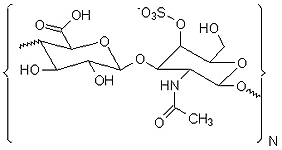 | 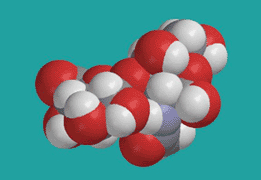 |
| Chondroitin building blocks; left is the chemical layout, showing one building block that can be repeated numerous times; this is basically a glucose molecule (left potion) and glucosamine molecule (right portion), which has been sulfated (O3S, at the top). This building block is illustrated to the right in a three-dimensional representation. | |
Long-chain sulfated polysaccharides, like chondroitin, also inhibit viruses; there is a Japanese patent for sea cucumber chondroitin sulfate for HIV therapy based on this action, and other sulfated polysaccharides from seaweeds have been patented as inhibitors of herpes viruses. Chondroitin is usually obtained in commercial quantities from bovine trachea or shark cartilage (including the shark fin), while glucosamine sulfate is obtained from shells of shrimp and crab. These compounds are also found in deer antler, which is not a practical source for extraction due to its rarity and cost, but it is likely that glucosamine and chondroitin are significant contributors to the medicinal action of deer antler.
Russian, Japanese, and Chinese studies reveal that sea cucumbers also contain saponins (triterpene glycosides). These compounds have a structure similar to the active constituents of ginseng, ganoderma, and other famous tonic herbs. Pharmacology studies indicate anti-inflammatory and anticancer properties of the sea cucumber saponins.
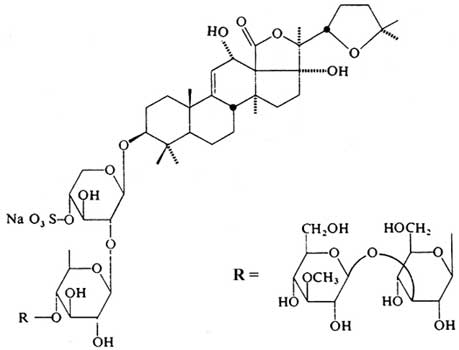
One of the sea cucumber saponins, representative of the structures commonly found in these organisms.
In addition, the sea cucumber oil contains two anti-inflammatory fractions. One fraction has fatty acids characteristic of those found in fish; they can be used as a substitute for fish oil in reducing inflammatory byproducts of fat metabolism, and to nourish the brain and heart. The main compounds of interest in fish oil are EPA (eicosapentaenoic acid also found in sea cucumber, and DHA (docosahaenoic acid), unique to fish:
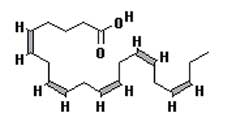 | 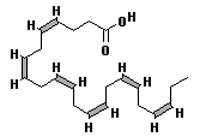 |
| Stereochemical representations of EPA (left) and DHA (right). The double bond locations are different, causing a different bending of the structures. | |
The other oil fraction is a mixture of branched chain fatty acids, mainly 12-MTA (methyltetradecanoic acid). This compound, and the more widely studied variant, 13-MTA, are potent inhibitors of the 5-LOX (lypoxygenase) enzyme system. 5-LOX inhibitors are one of the key areas of modern drug development, with plans evolving to use the compounds in treatment of asthma, ulcerative colitis, and arthritis. In addition, cancer-inhibiting effects have been observed in preliminary studies with prostate cancer cell lines and other human cancer cells These fatty acids are thought to be produced by bacteria that live within the sea cucumbers; they are also produced by bacteria in other marine organisms, such as sponges and tunicates.

Sample branched chain fatty acid found in sea organisms. The central chain is a simple carbohydrate.
These long chains can interact with cell membranes.
Bibliography
- Zhang Enchin (Chief Editor), Chinese Medicated Diet, 1988 Publishing House of Shanghai College of Traditional Chinese Medicine, Shanghai.
- Tang Weici, Chinese medicinal materials from the sea, Abstracts of Chinese Medicine 1987; 1(4): 571-600.
- Yang Peiying, et al., Inhibition of proliferation of PC3 Cells by the branched-chain fatty acid, 12-MTA, is associated with inhibition of 5-lipoxygenase, The Prostate 2003; 55: 281-291.
For pictures of sea cucumbers live, dried, and prepared as food, see the tour of illustrations at http://harmony.asiaep.com/cucumbe1.htm
 | 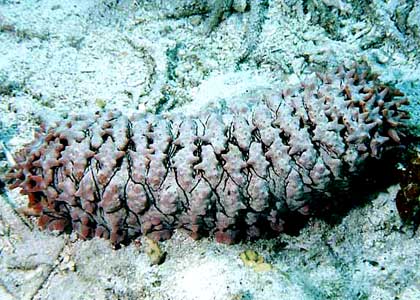 |
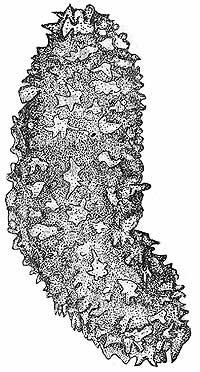 | 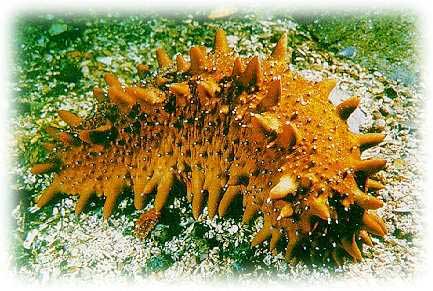 |
| Illustrated in a Chinese medicine book and photographed are Stichopus chloronotus, commonly called "greenfish" (top row) and Thelenota ananas, commonly called "pineapple sea cucumber" (bottom row). sumber : | |

Tidak ada komentar:
Posting Komentar